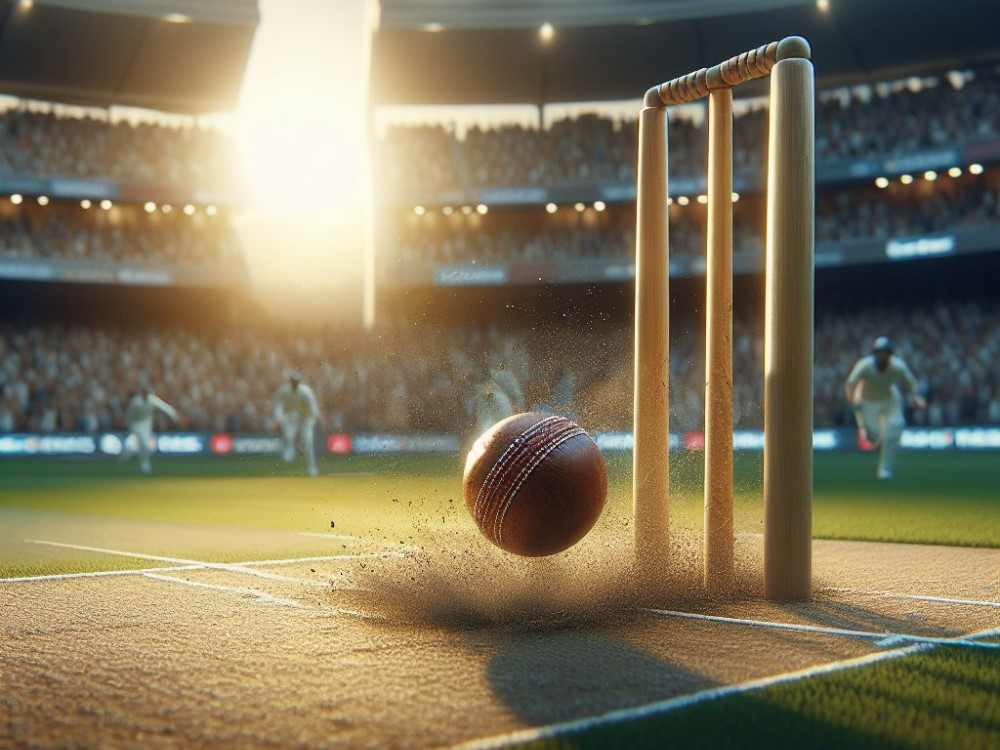
What Is The Difference Between Bowled And LBW
Cricket enthusiasts often come across terms like “bowled” and “LBW” while watching the game. While they may seem similar, there are distinct differences between bowled And LBW in cricket.
Bowled is a term used when the bowler successfully knocks down the batsman’s stumps, resulting in the batsman being declared out. This can occur if the bowler’s delivery hits the stumps directly or if the ball hits the batsman’s pad or body and then dislodges the bails from the stumps. A batsman gets bowled out when the ball completely dislodges at least one bail from the stumps.
On the other hand, LBW stands for “Leg Before Wicket.” It is a method of dismissal whereby the umpire judges that the ball would have hit the stumps if the batsman’s leg had not been in the way.
The ball must hit the batsman’s leg (or any part of the body in line with the stumps) in front of the wicket, while the batsman is attempting to play a shot. If the umpire deems it would have gone on to hit the stumps, the batsman is given out LBW.
The differences between “bowled” and “LBW” lie in the method of dismissal, criteria for dismissal, the role of fielders, and the umpire’s decision. While getting bowled involves the ball directly hitting the stumps or dislodging the bails after hitting the batsman, LBW focuses on the ball hitting the batsman’s leg in line with the stumps and the likelihood of it hitting the stumps.
Understanding these differences enhances the understanding and enjoyment of the game of cricket, as fans can recognize and appreciate the distinct ways in which batsmen can be dismissed.
What Is “bowled” in Cricket?

“Bowled” in cricket refers to a situation where the bowler successfully knocks down the batsman’s stumps, resulting in a dismissal. This occurs when the bowler delivers the ball directly onto the stumps, causing the bails to fall.
When a batsman is bowled, they are considered out and must leave the field. This particular form of dismissal is prevalent in cricket and is often accompanied by the distinctive sound of the ball hitting the stumps. Being bowled is a crucial aspect of the game, highlighting the importance of the bowler’s technique and accuracy.
How Does a Batsman Get “bowled” Out?
When a batsman is bowled out in cricket, it means that the ball has hit the wickets and dislodged at least one of the bails. So, if you’re wondering how does a batsman get “Bowled” out, here are the steps:
- The bowler bowls the ball towards the batsman.
- The ball pitches on the ground and hits the wicket.
- At least one of the bails is dislodged from the stumps.
- If the batsman fails to defend the wicket with their bat, the ball can hit the stumps directly, resulting in a “bowled” dismissal.
- The dismissal is confirmed by the umpire, and the batsman has to leave the field.
In the 1956 Test match between South Africa and England, English fast bowler Fred Trueman famously bowled South African batsman Geoff Griffin as the last wicket to secure a victory for England. Trueman’s skillful bowling and the excitement of the dismissal have become part of cricket’s rich history.
What Are the Consequences of A “bowled” Dismissal?

When a batsman is dismissed by being “Bowled” in cricket, it has significant consequences for the team. The consequences of a “Bowled” dismissal are immediate and profound. The batsman is instantly declared out and is required to leave the field.
This sudden departure can be a major setback for the batting side since they lose a key player from their lineup. As a result, it has the potential to impact the team’s momentum and ultimately affect the overall score of the match. It is worth noting that a “Bowled” dismissal, along with other forms of dismissal, has the power to dramatically alter the course of the game.
Fun Fact: Did you know that the fastest recorded delivery in the history of cricket was bowled by Shoaib Akhtar? It was recorded at a mind-boggling speed of 161.3 km/h (100.23 mph).
What Is “LBW” in Cricket?
In cricket, “LBW,” known as Leg Before Wicket, is a crucial rule that adds strategic complexity to the game. It occurs when the ball is obstructed from hitting the wicket by a batsman’s leg, resulting in an out.
To determine LBW, certain conditions must be met, including the ball pitching in line with the stumps, striking the batsman’s leg without hitting the bat, and eventually hitting the stumps. Umpires make LBW decisions by following guidelines provided by the International Cricket Council. This rule ensures fairness and maintains the integrity of the game.
What Does “LBW” Stand For?
In cricket, “LBW” stands for “Leg Before Wicket.” It is a common term used to describe a mode of dismissal in which the batsman is deemed to have stood in the way of the ball hitting the wicket with their leg, without offering any shot.
When a batsman gets dismissed by LBW, it means that the ball would have gone on to hit the wicket if their leg had not obstructed it. The umpire has the final decision on whether a batsman is out LBW based on various criteria, including the position of the ball and the batsman’s stance.
How Does a Batsman Get Dismissed By “LBW”?

In cricket, a batsman can be dismissed by LBW, which stands for Leg Before Wicket. LBW occurs when the bowler delivers a ball that would have hit the wicket, but the batsman’s leg obstructs its path.
To be given out, certain criteria must be met, including whether the ball pitched in line with the wickets and if it would have gone on to hit the stumps. The umpire decides whether the batsman is out or not. LBW is different from being bowled out, where the ball hits the wickets directly.
A batsman can get dismissed by LBW if the bowler delivers a ball that would have hit the wicket and the batsman’s leg obstructs its path. Certain criteria need to be met, such as pitching in line with the wickets and having the potential to hit the stumps. Ultimately, it is the umpire who decides whether the batsman is out or not. This dismissal is different from being bowled out, which occurs when the ball directly hits the wickets.
The significance of being dismissed by LBW was demonstrated in a true story where a crucial match took place. In that match, a batsman got dismissed by LBW when a delivery swung in and struck his pad. This resulted in a loud appeal from the opposing team. After a tense review, the decision was given in favor of the fielding team, leading to a major turning point in the game.
Differences Between “Bowled” and “LBW”
Discover the intriguing distinctions between “bowled” and “LBW” as we dive into the realm of cricket dismissals. Step into the world of the crease and explore the various aspects that shape these two important facets of the game.
Uncover the methods of dismissal, delve into the criteria for determining a player’s fate, and unravel the crucial roles played by fielders and umpires. Get ready for an enlightening journey that uncovers the nuances of “bowled” and “LBW” in the exciting sport of cricket.
Method of Dismissal

The method of dismissal in cricket can be categorized into two types: being “bowled” and being dismissed by “LBW” (leg before wicket). Here is a comparison of the two methods:
The method of dismissal in cricket can occur through two main methods: being bowled or being dismissed leg before wicket (LBW).
When a batsman is bowled, it means the bowler successfully hits the stumps directly with the ball, causing the bails to dislodge. Conversely, with LBW, the ball strikes the batsman’s pads, preventing it from hitting the stumps.
For a bowled dismissal, the only criterion is hitting the stumps, while for LBW, the ball must hit the pads and would have hit the stumps if the pads weren’t there, and it must be evident that the batsman wasn’t attempting a shot.
Fielders do not play a direct role in either type of dismissal, although their appeal is crucial for the umpire’s decision. Ultimately, the umpire’s decision hinges on whether the ball hit the stumps for a bowled dismissal or if it hit the pads in the correct line, would have hit the stumps, and whether the batsman attempted a shot for an LBW dismissal.
Considering these differences, it is important for cricketers and fans to understand the method of dismissal in order to fully comprehend the game. Have a good understanding of these rules and enjoy the sport better!
Criteria for Dismissal
When it comes to the criteria for dismissal in cricket, there are distinct differences between being “bowled” and being dismissed by “LBW” (Leg Before Wicket).
The criteria for dismissal in cricket can be categorized into two methods: being “bowled” and being dismissed by “LBW” (Leg Before Wicket).
1. Method of Dismissal: A batsman is “bowled” when the ball hits the stumps directly without being touched by the bat. On the other hand, “LBW” refers to a dismissal where the ball would have hit the stumps if not intercepted by the batsman’s body.
2. In the case of being “bowled,” the criteria for dismissal are clear – the ball must hit the stumps. For an “LBW” dismissal, certain conditions need to be met, such as the ball pitching in line with the stumps and the impact being in line with the stumps.
3. Role of Fielders: In a “bowled” dismissal, the fielders play no role in the batsman’s dismissal. Conversely, in an “LBW” dismissal, fielders may appeal for the decision, and the umpire determines whether the batsman is out.
4. Umpire’s Decision: The umpire makes a straightforward decision in a “bowled” dismissal as the ball hitting the stumps is visible. In an “LBW” dismissal, the umpire needs to analyze various factors and make a judgment based on the cricket rules.
Understanding these criteria for dismissal is vital for both players and spectators to comprehend the specific circumstances leading to a batsman being ruled out in a cricket match.
Role of Fielders

The role of fielders in cricket is crucial for both “bowled” and “LBW” dismissals. Here are their assigned tasks:
- Catching: Fielders positioned near the batsman strive to catch the ball whenever it is hit in the air. If successfully caught, the batsman is eliminated.
- Fielding: Fielders aim to prevent the ball from crossing the boundary, thereby reducing the batsman’s opportunities to score runs.
- Throwing: Fielders endeavor to hit the stumps in order to run out the batsman. A direct hit can result in a “bowled” dismissal.
- Awareness: Maintaining constant alertness, fielders are ready to seize catching opportunities or make run-outs whenever they arise.
Pro-tip: An excellent level of coordination among fielders can enhance the chances of obtaining wickets and limit the opposition’s scoring.
Umpire’s Decision
The decision made by the umpire is a crucial aspect of cricket. It plays a vital role in determining whether a batsman is out or not. The umpire, following the rules and regulations set by the cricket governing body, is responsible for making fair and unbiased judgments during the game.
Their accuracy in making decisions relies on their expertise, experience, and knowledge of the game. These decisions include assessing if the ball hit the stumps (bowled) or if the batsman’s leg obstructed the ball’s path (LBW). The significance of the umpire’s decision in cricket matches cannot be underestimated, as it has the potential to greatly influence the outcome of the game.




